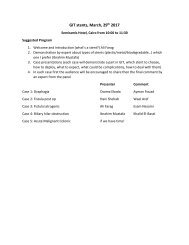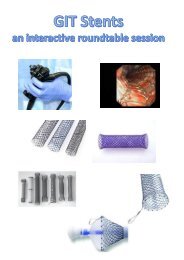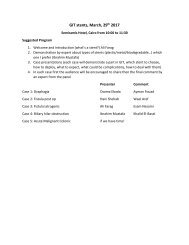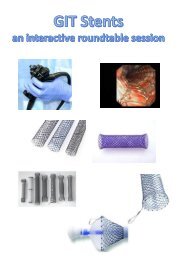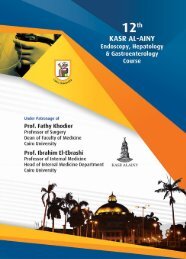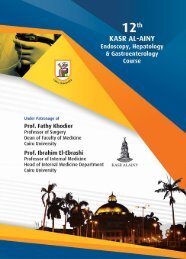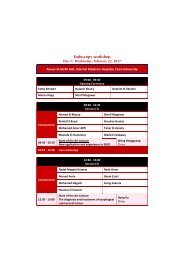Management of DAAs Failure
If you have failure of plan A in treating a patient with chronic hepatitis C. What's your plan B
If you have failure of plan A in treating a patient with chronic hepatitis C. What's your plan B
Create successful ePaper yourself
Turn your PDF publications into a flip-book with our unique Google optimized e-Paper software.
<strong>Management</strong> <strong>of</strong> <strong>DAAs</strong> <strong>Failure</strong><br />
Pr<strong>of</strong>. Gamal Esmat<br />
Pr<strong>of</strong>. Hepatology &Ex. Vice President <strong>of</strong> Cairo University, Egypt<br />
Member <strong>of</strong> WHO Strategic Committee for Viral Hepatitis<br />
www.gamalesmat.com
3D-model <strong>of</strong> HCV comprising envelope, core proteins & single,<br />
positive RNA strand<br />
Envelope glycoprotein 1 (E1) 2<br />
Envelope glycoprotein 2 (E2) 1,2<br />
HCV RNA 1<br />
P21 Core protein 1,2<br />
55–56 nm 1<br />
HCV, Hepatitis C virus; RNA, Ribonucleic acid<br />
1. Krekulova L, et al. Folia Microbiol 2006;51:665-80; 2. Mauss S, et al. The Flying Publisher Short Guide to Hepatitis C. 2012 Edition. Available at:<br />
http://www.flyingpublisher.com (last accessed 12 October, 2012)
• HCV is an enveloped, positive-sense, single-stranded RNA virus that replicates using<br />
RNA polymerase that lacks general pro<strong>of</strong>-reading ability.<br />
• This error-prone RNA polymerase is responsible for the genetic variability exhibited by<br />
HCV isolates.The spontaneous nucleotide substitution rate <strong>of</strong> HCV is high, with a<br />
frequency <strong>of</strong> 10 2 to 10 3 substitutions per nucleotide site per year<br />
• Accumulation <strong>of</strong> nucleotide substitution in the HCV genome results in alteration and<br />
evolution into distinct genotypes, subtypes
Sequence homology <strong>of</strong> whole genome and<br />
specific genes among HCV classifications
Antiviral Resistance<br />
• Each patient carries a preexisting<br />
heterogeneous population <strong>of</strong><br />
viruses:<br />
Sensitive viral variants (wild-type)<br />
Resistant viral variants<br />
– Wild-type: dominant and drugsensitive<br />
– Resistant-associated variants<br />
/substitutes) minority population(<br />
• The selection <strong>of</strong> drug- resistant<br />
variants has been observed in<br />
patient who had treatment failure.
Mechanism <strong>of</strong> resistance<br />
• Most resistant variants are unfit and may be undetectable prior to therapy<br />
• Resistant variants are present before and can be selected during treatment<br />
Antiviral therapy eliminates sensitive variants<br />
Resistant variants expand<br />
Sensitive virus<br />
Resistant virus<br />
Antiviral therapy<br />
1. Pawlotsky JM. Clin Liver Dis. 2003;7:45-66. 2. Kuntzen T, et al. Hepatology. 2008;48:1769-1778.<br />
3. Bartels DJ, et al. J Infect Dis. 2008;198:800-807. Image reproduced and adapted with permission from Forum for Collaborative HIV Research.<br />
www.hivforum.org
All <strong>DAAs</strong> Can Select Resistant Variants<br />
Ala156<br />
Arg155<br />
Asp168<br />
Val36<br />
Thr54<br />
Pawlotsky JM. Ther Adv Gastroenterol 2009;2:205–219; Donaldson et al., Hepatology 2015;61(1):56-65; Lam et al., Antimicrob Agents<br />
Chemother 2012;56(6):3359-68.
Multiple factors can affect the emergence <strong>of</strong><br />
resistance variants, particularly:<br />
1. The overall potency<br />
2. Barrier to resistance <strong>of</strong> the combination<br />
regimen
Barrier to Resistance<br />
Low-barrier drugs<br />
High-barrier drugs
HCV NS3/4A Protease Resistance<br />
D168<br />
R155<br />
Q80<br />
F43<br />
A156<br />
Lenz O, et al. Antimicrob Agents Chemother. 2010;54:1878-1887. Reproduced with permission from American Society for Microbiology. doi:10.1128/AAC.01452-09 Copyright © 2010, American Society for<br />
Microbiology. All Rights Reserved.
NS5B RAV(S)<br />
• S<strong>of</strong>osbuvir has a high resistance barrier.<br />
• Although the S282T mutation has been selected in all genotypes during<br />
in vitro studies, the clinical significance <strong>of</strong> this RAV is unclear; it has<br />
been found in 1 <strong>of</strong> 1545 trial participants, who was not cured.<br />
• Yet successful re-treatment with s<strong>of</strong>osbuvir may be possible, even for<br />
people who were not cured by a s<strong>of</strong>osbuvir-containing regimen
Post-treatment RAV(S) persistence in patients who failed<br />
to achieve SVR
Protease inhibitor-Resistant Viruses are Progressively Replaced by WT-<br />
Sensitive Viruses after Rx <strong>Failure</strong>s<br />
Lenz et al., J Hepatol 2015;62(5):1008-14.
Pts With NS5A RAVs (%)<br />
Durability <strong>of</strong> Treatment-Emergent NS5A RAVs After<br />
Virologic <strong>Failure</strong><br />
• NS5A RAVs persisted in majority <strong>of</strong> pts for 96 wks<br />
100<br />
80<br />
98 100 98 100<br />
95<br />
86<br />
60<br />
40<br />
n/N =<br />
20<br />
0<br />
62/<br />
63<br />
58/<br />
58<br />
42/<br />
43<br />
VF Baseline FU-12 FU-24 FU-48 FU-96<br />
45/<br />
45<br />
Registry Study<br />
52/<br />
55<br />
50/<br />
58<br />
Dvory-Sobol H, et al. EASL 2015. Abstract O059.
SVR12 (%)<br />
24 Wks <strong>of</strong> LDV/SOF Retreatment After <strong>Failure</strong> <strong>of</strong> 8-12 Wks <strong>of</strong><br />
LDV/SOF-Based Tx<br />
• GT1 HCV–infected pts with and without cirrhosis previously treated with 8 or 12 wks <strong>of</strong> LDV/SOF ± RBV<br />
100<br />
100<br />
80<br />
60<br />
71 68<br />
74<br />
80<br />
46<br />
60<br />
40<br />
n/N =<br />
20<br />
0<br />
29/<br />
41<br />
Lawitz E, et al. EASL 2015. Abstract O005.<br />
15/<br />
22<br />
14/<br />
19<br />
All No Yes<br />
Cirrhosis<br />
24/<br />
30<br />
5/<br />
11<br />
8 Wks 12 Wks<br />
Previous Tx<br />
Duration<br />
11/<br />
11<br />
No<br />
18/<br />
30<br />
Yes<br />
BL NS5A RAVs
Guidelines <strong>of</strong> the National Treatment Program in Egypt<br />
• Patients who failed previous S<strong>of</strong>osbuvir containing regimen<br />
• Treatment will be with S<strong>of</strong>osbuvir + Daclatasvir + Ribavirin<br />
Or<br />
S<strong>of</strong>osbuvir + ledipasvir +ribavirin<br />
• for 24 weeks.<br />
• The dose <strong>of</strong> ribavirin is 600 mg/day in cirrhotics, A trial should be done to<br />
reach a dose <strong>of</strong> 1000 mg/day based on the patient tolerability
DAA Treatment <strong>Failure</strong><br />
•Relapse or Reinfection.<br />
•RAV (RAS) testing(if not available).<br />
•S<strong>of</strong>o +Rib+ change from protease to NS5A<br />
inh.<br />
or vice versa.<br />
•24 weeks
Treatment recommendations for retreatment <strong>of</strong> HCV who failed to<br />
achieve SVR on prior antiviral therapy containing one or several<br />
<strong>DAAs</strong><br />
‡<br />
Patients who failed to achieve SVR with SOF + RBV or SOF + RBV + PegIFN-α<br />
LDV/SOF<br />
SOF/VEL<br />
OBV/PTV/<br />
RTV ± DSV<br />
GZR/EBR SOF + DCV SOF + SMV<br />
GT1 or<br />
GT4<br />
12 weeks + RBV<br />
(F0-F2) or<br />
24 weeks + RBV<br />
(F3-F4)<br />
12 weeks + RBV<br />
(F0-F2) or<br />
24 weeks + RBV<br />
(F3-F4)<br />
12 weeks + RBV (F0-<br />
F2) or<br />
24 weeks + RBV (F3-<br />
F4)<br />
(For GT4 no DSV)<br />
12 weeks +RBV (F0-F2 with<br />
HCV RNA≤800,000 (5.9 log)<br />
IU/ml) or 24 weeks +RBV (F0-<br />
F2 with HCV RNA>800,000<br />
(5.9 log) IU/ml and F3-F4)<br />
12 weeks + RBV<br />
(F0-F2) or<br />
24 weeks + RBV<br />
(F3-F4)<br />
-12 weeks + RBV<br />
(F0-F2) or<br />
24 weeks + RBV (F3-<br />
F4)<br />
GT2 or<br />
GT3<br />
-<br />
12 weeks + RBV<br />
(F0-F2) or<br />
24 weeks + RBV<br />
(F3-F4)<br />
- -<br />
12 weeks + RBV<br />
(F0-F2) or<br />
24 weeks + RBV<br />
(F3-F4)<br />
-<br />
GT5 or<br />
GT6<br />
12 weeks + RBV<br />
(F0-F2) or<br />
24 weeks + RBV<br />
(F3-F4)<br />
12 weeks + RBV<br />
(F0-F2) or<br />
24 weeks + RBV<br />
(F3-F4)<br />
- -<br />
12 weeks + RBV<br />
(F0-F2) or<br />
24 weeks + RBV<br />
(F3-F4)<br />
-<br />
•EASL Recommendations on Treatment <strong>of</strong> Hepatitis C 2016; Journal <strong>of</strong> Hepatology 2016<br />
http://dx.doi.org/10.1016/j.jhep.2016.09.001 (Accessed September 2016)
Treatment recommendations for retreatment <strong>of</strong><br />
HCV who failed to achieve SVR on prior antiviral<br />
therapy containing one or several <strong>DAAs</strong><br />
‡<br />
‡<br />
Patients who failed to achieve SVR with a PegIFN-α and telaprevir, or boceprevir, or simeprevir<br />
GT1<br />
LDV/SOF<br />
12 weeks +<br />
RBV<br />
SOF/VEL<br />
12 weeks +<br />
RBV<br />
OBV/PTV/<br />
RTV + DSV<br />
OBV/PTV/<br />
RTV<br />
- - -<br />
GZR/EBR SOF + DCV SOF + SMV<br />
12 weeks<br />
+ RBV<br />
-<br />
Patients who failed to achieve SVR with a SOF + SMV<br />
LDV/SOF<br />
SOF/VEL<br />
OBV/PTV/<br />
RTV + DSV<br />
OBV/PTV/<br />
RTV<br />
GZR/EBR SOF + DCV SOF + SMV<br />
GT1<br />
or<br />
GT4<br />
12 weeks +<br />
RBV (F0-F2)<br />
or<br />
24 weeks +<br />
RBV (F3-F4)<br />
12 weeks +<br />
RBV (F0-F2)<br />
or<br />
24 weeks +<br />
RBV (F3-F4)<br />
- - -<br />
12 weeks + RBV<br />
(F0-F2) or<br />
24 weeks + RBV<br />
(F3-F4)<br />
-<br />
•EASL Recommendations on Treatment <strong>of</strong> Hepatitis C 2016; Journal <strong>of</strong> Hepatology 2016<br />
http://dx.doi.org/10.1016/j.jhep.2016.09.001 (Accessed September 2016)
Treatment recommendations for retreatment <strong>of</strong><br />
HCV who failed to achieve SVR on prior antiviral therapy<br />
containing one or several <strong>DAAs</strong><br />
‡<br />
SOF/VEL +<br />
RBV<br />
Patients who failed to achieve SVR with a NS5A-based regimen<br />
(LDV, VEL, OMV, EBR, DCV)<br />
SOF + OMV/PTV/RTV +<br />
DSV<br />
SOF + OMV/PTV/RTV<br />
+RBV<br />
SOF +<br />
GRZ/EBV<br />
+ RBV<br />
SOF +<br />
DCV + SMV<br />
+ RBV<br />
GT1a 24 weeks - 24 weeks 24 weeks<br />
GT1b<br />
F0–F2 12 weeks<br />
F3–F4 24 weeks<br />
- F0–F2 12 weeks<br />
F3–F4 24 weeks<br />
GT 3 24 weeks - - - -<br />
GT 4<br />
F0–F2 12 weeks<br />
F3–F4 24 weeks<br />
GT 5/6 24 weeks - - - -<br />
•EASL Recommendations on Treatment <strong>of</strong> Hepatitis C 2016; Journal <strong>of</strong> Hepatology 2016<br />
http://dx.doi.org/10.1016/j.jhep.2016.09.001 (Accessed September 2016)<br />
The regimens shown are not EMA approved regimens for retreatment <strong>of</strong> patients who failed to achieved SVR. The only<br />
regimen approved is SOF/VEL+RBV for 24 weeks in GT3 only.
A- Retreatment <strong>of</strong> patients with previous SOF/DAC failure<br />
1- Non cirrhotics and compensated cirrhotic patients:<br />
• Option I: SOF/Qurevo/RBV for 12 weeks.<br />
• Option II : SOF/SIM/DAC/RBV for 12 weeks<br />
• RBV ineligible: extend therapy for 24 weeks
A- Retreatment <strong>of</strong> patients with previous SOF/DAC failure<br />
1- Non cirrhotics and compensated cirrhotic patients:<br />
• Option I: SOF/Qurevo/RBV for 12 weeks.<br />
• Option II : SOF/SIM/DAC/RBV for 12 weeks<br />
• RBV ineligible: extend therapy for 24 weeks
A- Retreatment <strong>of</strong> patients with previous SOF/DAC failure<br />
2- Child’s B cirrhotic patients:<br />
SOF/DAC/RBV for 24 weeks<br />
Deferred treatment for Child C, Relapsers to S<strong>of</strong>o+Dacla<br />
24weeks
Future Therapy <strong>of</strong> HCV<br />
With the help <strong>of</strong> God<br />
We will keep trying with Every New Day
Abstract ID: 849<br />
Author: Ng T. et al.<br />
Analysis <strong>of</strong> HCV Variants in the MAGELLAN-1 Part 1 Study:<br />
• Number <strong>of</strong> patients: n=50.<br />
AASLD 2016<br />
ABT-493 and ABT-530 Glecaprevir/Pibrentasvir(G/P) Combination Therapy <strong>of</strong> Genotype 1-<br />
Infected Patients<br />
who Had Failed Prior Direct Acting Antiviral-Containing Regimens<br />
• These DAA-experienced patient cohorts had broad representation <strong>of</strong> baseline variants at key<br />
resistance-associated positions, including those at NS3 V36, Q80, R155, and D168, as well as<br />
NS5A M28, Q30, L31, and Y93.<br />
• Results: All patients with baseline variants at position Y93 in NS5A that confer high level <strong>of</strong><br />
resistance to currently approved NS5A inhibitors achieved SVR12<br />
• Conclusions: The combination <strong>of</strong> ABT-493 and ABT-530 demonstrated potent antiviral activity<br />
and a high barrier to resistance in non-cirrhotic HCV GT1-infected patients who had previously<br />
failed a DAA-containing regimen,
AASLD 2016<br />
S<strong>of</strong>osbuvir/Velpatasvir/Voxilaprevir<br />
for 12 Weeks<br />
as a Salvage regimen in NS5A Inhibitor –Experienced<br />
Patients with Genotype 1-6 Infection : The Phase 3<br />
POLARIS-1 Study
Summary<br />
• Treatment-emergent RAV(S) seen in treatment failure and in all DAA classes and<br />
rarely with SOF<br />
• NS3 RAVs have low replication efficacy and disappear over 9-18 mos<br />
• If considering SMV + SOF: In treatment-naive and treatment-experienced pts<br />
with both genotype 1a HCV infection and compensated cirrhosis, ensure no<br />
Q80K<br />
• NS5A treatment-emergent RAVs persistent and a clinical challenge<br />
• If failure with any NS5A inhibitors , and treatment is urgent, test for NS3 and<br />
NS5A RAVs<br />
• Use SMV + SOF + RBV if NS5A but no NS3 RAVs<br />
• Use LDV/SOF orDacla + RBV if no NS5A RAVs<br />
• Treat in clinical trial if both NS5A and NS3 RAVs present
THANK YOU<br />
please visit<br />
www.gamalesmat.com<br />
You can see this presentation and more




